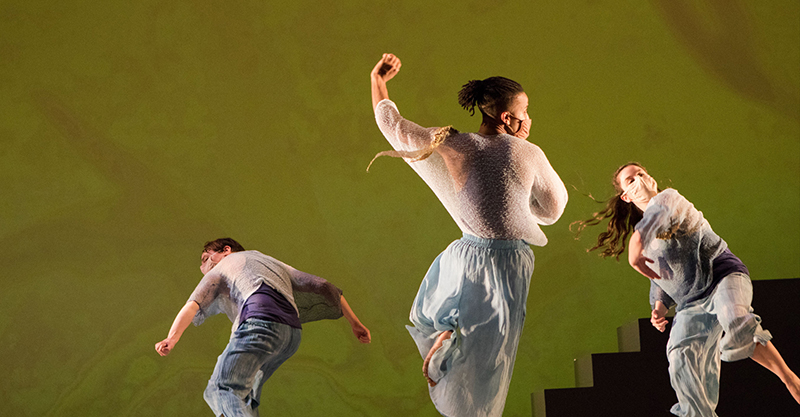In the Champaign-Urbana dance scene, the start of February means one thing: it’s time for Dance at Illinois’ February Dance concert. Excited for a sneak peek at what’s in store, I reached out to concert director Rachel Rizzuto, who, by the way, will also be performing in Tere O’Connor’s piece, “Future Cake.” A graduate of Dance @ Illinois’ MFA program, Rizzuto has clearly been making her 2021-22 faculty appointment count. Here’s what she shared with me about this week’s upcoming performances.
Smile Politely: How would you describe the 2022 February Dance program?
Rachel Rizzuto: I’d say that the program is very eclectic—these four works feel like deep explorations of each choreographer’s current research interests, ranging from memory/identity/home to what dance can be without a dependence on unison to motion-capture looping technology to exertion and drive. I love how distinctive of its own world each piece feels.
SP: How are the dancers and choreographers faring with the return to live performance?
Rizzuto: They must have missed it so much. I think everyone is cautiously optimistic—we’re taking extra precautions around testing and masking in order to keep our performers and audience safe, but we’re also—as usual—not letting those restrictions put a cramp on the creativity inherent in these works or the dancers’ performance of them. Some of these four pieces have been in development for a while—Tere O’Connor’s piece had its first origins in the spring semester of 2021, as part of a class in the dance department called Choreolab, where faculty members get an entire semester to work with interested students on a new piece. That said, the dance department has become very adept at adapting performance for the pandemic and its ever-changing restrictions. We’ve found ways to perform our work even as far back as spring 2020, so this concert is no exception!
In her program notes, Rizzuto shares how the choreographers of February Dance 2022 have risen to the challenges of creating and performing in a pandemic, and gone on to explore notions of family, identity, movement, and momentum.
As we near the two-year anniversary of when our lives as we knew them suddenly and irrevocably changed, it’s worth noting that dance has somehow managed to press on in the face of the pandemic—to thrive, even. The two-year COVID-19 retrospective accounts and what-couldhave-been op-eds might be mounting, but dance has, as ever, found its own forward momentum. We’ve created dance films, performed in masks, rehearsed in 10 by 10 squares, taken class outside and from our living rooms on Zoom, but we’ve never stopped making, questioning, and searching. The four faculty-choreographed works you’ll see tonight are evidence of that staggering forward momentum. Roxane D’Orléans Juste’s meditative solo is really a duet in disguise, one concerned with memory and its inextricableness from identity and family. Tere O’Connor’s “Future Cake” examines our obsession with unison in dance and gently guides us to instead uncover the choreographic bounty and community innate in plurality. In her work “Fallow,” Cynthia Oliver uses the exhaustion and depletion that inevitably accompany drive, not as means to a necessary end but as onsets—as opportunities to lean in. John Toenjes marries dance and technology in fresh, invigorating ways as dancers compete for audience approval via sonic and movement improvisations. As concert director, I am honored to present these excellent dances, all incontrovertible proof that, in times of uncertainty, this art form is a balm for our souls. Dance grounds and feeds us— and it’s never been more essential.
—Rachel Rizzuto, concert director
SP: What are you most excited for audience members to experience?
Rizzuto: I think the movement and idea diversity inherent in these four works makes them exciting for audience members to experience. I love that a single concert can include a work like John Toenjes’, where two teams of dancers improvise vocally and movement-wise in order to garner audience support, as well as one like Roxane d’Orléans Juste’s, which is ostensibly a solo incorporating how memory informs identity but also includes video projection of her sister (who is also a dancer!).
SP: Dance at Illinois will be continuing the hybrid model of a three day run of live performances followed by extended access to a streamed performance. Do you think this model will continue for the foreseeable future?
Rizzuto: Watching dance on a TV or device is so different from attending a live performance, or a dance film. But I do see its possibilities, especially in terms of creating broader access. What are your thoughts? I don’t actually know what the university’s plans are for the future of livestreaming, so I will politely decline to answer this one. I will say that Dance at Illinois is always excited to find new ways to bring our work to audiences that might not otherwise get the chance to see this concert—most especially, our families and alums who live all over the country and the world.
February Dance 2022
February 3rd-5th, 7:30 p.m.
Krannert Center for the Performing Arts
Tryon Festival Theatre
500 S Goodwin, Urbana
Tickets: $10-$40; order online here
Performances are 1 hour and 45 minutes, including a 20 minute intermission.
COVID 19 protocols include masking and proof of vaccination.
February Dance 2022 will also be available for online access from February 2nd through February 21st. Access is free, but donations are appreciated.








